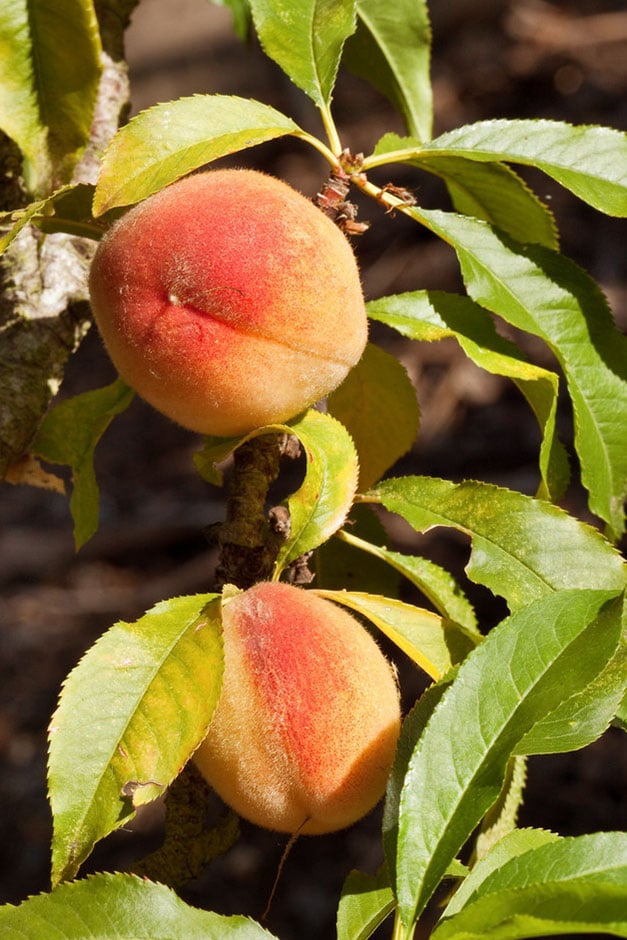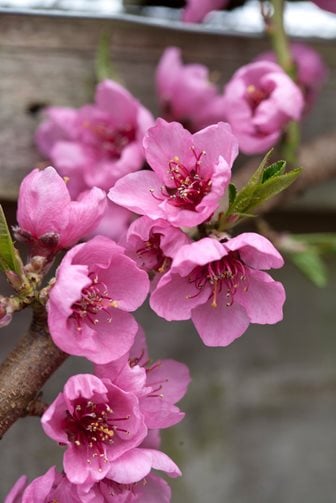 Botanical name: Prunus persica
Botanical name: Prunus persica- Origins: Although its botanical name, which literally translates as ‘Persian plum’, suggests the peach originated from Persia (modern-day Iran), genetic research indicates that it actually comes from China.
- First cultivated: Peaches have been cultivated in China since the Neolithic period.
- Types: Peaches are classified as either clingstone or freestone, depending on whether the flesh adheres to the stone or not. There are early and late varieties, fruit with white, yellow or red flesh, and dwarf varieties which can be grown in containers. Nectarines are also classed as Prunus persica.
- RHS advice: how to grow peaches
Did you know?
Peaches have been cultivated in China for thousands of years, with evidence suggesting that domestication of the fruit occurred as early as 6000 BC in Zhejiang Province. From China, the fruit travelled west via the Silk Route to Persia where it was widely cultivated, earning it the botanical name
Prunus persica.
Alexander the Great is credited with introducing the fruit to Europe after he conquered Persia, although peaches weren’t widely known in England until the 17th century, and even then they were regarded as a rare treat.
Tales from the Far East
Peaches have always had a special significance in their native China, where they are symbolic of unity and immortality. According to Chinese mythology, they confer longevity on all who eat them. The symbol of the peach frequently appears in Chinese legend, art and literature, and Chinese brides traditionally carry peach blossoms in their bouquets.
The Japanese associate peaches with purity and the banishment of evil, after their famous folktale
Momotaro or ‘Peach Boy’. This ancient legend tells the tale of a boy who was born from a peach and grew up to be a brave hero who fought evil demons. He is one of the most well-known characters in Japan and is regarded as a role-model for children because of his kind-heartedness and bravery. A festival takes place in his honour on May 5 every year in the Japanese city of Inuyama.
Peach trees and fruit often appear in European art and literature. They have prominently featured in paintings by famous artists including Caravaggio, Renoir, Monet, Manet and Van Gogh, variously symbolising love, health, beauty, fertility, sensuality and the transience of life.
 Family values
Family values
A member of the rose family, the peach is closely related to the almond, and is a sweet and fragrant stone fruit that can be used in a variety of culinary ways. Aside from the obvious jams, cakes, tarts, pies, cobblers and smoothies, peaches also lend themselves to savoury dishes such as salads, pizzas and soups, and they make an excellent accompaniment to meats.
Low in calories and high in fibre, peaches are a good source of vitamins A and C. Including the fruit in your diet can help maintain healthy bones and teeth, boost the immune system, and improve the skin. Peaches are rich in zinc which is thought to have anti-aging properties, and oils from the fruit are widely used in the cosmetics industry.
Despite their exotic origins, peaches have been successfully grown in the UK for hundreds of years, and they are a beautiful addition to any garden. They are one of the first fruit trees to flower, their delicate pink blossoms perfuming the early spring air, and in summer, you’ll be rewarded with an abundance of sweet and juicy fruit. The taste of a homegrown, sun-ripened peach is as good as it gets, and a world away from the peaches you buy from the supermarket.

